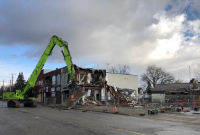Support strong Canadian climate journalism for 2025
This story was originally published by Grist and appears here as part of the Climate Desk collaboration.
A year ago, a different kind of pipeline project was announced in the Midwest. Most pipelines pick up oil or gas from a well and deliver it to customers who burn it, emitting carbon dioxide into the atmosphere. This one would run almost in reverse. A company called Summit Climate Solutions planned to capture carbon dioxide from ethanol refineries in Iowa, Minnesota, Nebraska, and the Dakotas, and then transport it via the proposed pipeline to a site in North Dakota where the CO2 would be buried deep underground.
In the months since, two more companies have proposed similar CO2 pipeline projects in the Midwest, and another wants to expand an existing pipeline in the South. The sudden boom is being driven by federal and state incentives for carbon capture and storage, or CCS, as well as a new low-interest loan program for CO2 pipelines passed by Congress last year and general support from the Biden administration to grow the “carbon management” industry in an effort to reduce carbon emissions.
But as the number of pipeline proposals multiplies, a new report commissioned by the Pipeline Safety Trust, a non-profit advocacy group, warns that CO2 pipeline regulations aren’t up to the task of keeping communities safe.
“The country is ill-prepared for the increase of CO2 pipeline mileage being driven by federal CCS policy,” writes report author Richard Kuprewicz, an independent pipeline safety consultant hired by the Pipeline Safety Trust. “Federal pipeline safety regulations need to be quickly changed to rise to this new challenge, and to assure that the public has confidence in the federal pipeline safety regulations.”
Pipeline safety is overseen by the Pipeline and Hazardous Materials Safety Administration, or PHMSA, a subdivision of the U.S. Department of Transportation. The agency began regulating carbon dioxide pipelines in 1991. Today, there are just over 5,000 miles of CO2 pipelines in the U.S., most of which deliver CO2 to oil fields, where companies pump it underground to stimulate oil production. But researchers assert that capturing carbon dioxide from industrial facilities and sucking CO2 directly from the air will be essential tools to tackle climate change. In order to deliver that CO2 to sites where it can be permanently sequestered underground, they estimate the U.S. could need between 30,000 and 65,000 miles of pipeline.
The most concerning finding in the new report, according to Bill Caram, executive director of the Pipeline Safety Trust, is that regulations for assessing the potential impacts of a CO2 pipeline rupture were not developed specifically for CO2. Every pipeline developer has to identify potential “high consequence areas” where an accidental release would have significant negative impacts on human health or the environment. High consequence areas for oil and gas pipelines are well-defined, but the report notes that CO2 has different considerations and likely a much larger radius of concern. CO2 is heavier than air, and a plume of CO2 can travel for miles, depending on wind and terrain, and settle into low-lying areas. The report warns that such an event would be difficult for people in the vicinity and first responders to detect since CO2 is colourless, odourless and nonflammable.
“If I had to pick one finding of the report that would keep me up at night as a public safety advocate, it’s that one,” said Caram.
The residents of Satartia, Miss., learned this the hard way in 2020 when a CO2 pipeline ruptured and a plume of CO2 settled over the town, causing people to feel dizzy, nauseous, and disoriented. Many passed out. Forty-nine people went to the hospital. PHMSA has yet to release an incident report detailing the cause of the rupture.
“That incident happened over two years ago,” said Caram. “It’s crazy that communities are being asked to bear the burden of the risk of these pipelines when this report sits unreleased with all these unanswered questions.”
In addition to urging PHMSA to update how potential impact areas are assessed, the Kuprewicz report recommends that PHMSA require pipeline operators to inject an odourant into CO2 pipelines, as is standard for natural gas pipelines, to help alert the public to potentially dangerous leaks. It proposes new requirements for informing and training local officials and emergency responders on the unique dangers posed by a CO2 release. It also recommends setting purity standards for the CO2 transported by pipelines, as impurities can introduce additional risks.
A spokesperson for PHMSA did not comment on the missing Satartia report or the concerns raised in Kuprewicz’s report. But the agency did say it was reviewing his findings and working on new measures to strengthen safety standards for CO2 pipelines, as the White House instructed PHMSA and other agencies that oversee CCS projects to do in interim guidance put out in February.
Similar to Kuprewicz, the White House guidance calls for CO2 pipeline-specific emergency planning and training. It cites a need for new tools to monitor and improve safety but stops short of describing which tools are needed. It also notes that the impacts of climate change, like flooding and storms, should be taken into account in the design, construction, and maintenance of CO2 pipelines.
Lee Beck, global director for carbon capture at the Clean Air Task Force, a non-profit that advocates for CCS deployment, said the Pipeline Safety Trust report “provides important insights and raises really important questions.” But from her perspective, the Biden administration’s guidance document shows it “is well aware of what needs to be done to ensure regulatory safety.” Beck also noted that since 2010, there have only been 66 reported CO2 pipeline incidents and no reported fatalities. According to PHMSA data, the incident rate per mile of CO2 pipeline in 2020 was about half that of crude oil pipelines.
But Caram is concerned that PHMSA does not have the funding or capacity to effectively make new rules. “I would consider them a notoriously underfunded and understaffed agency,” he said.
Rory Jacobson, the deputy director of policy at the non-profit Carbon180, also raised this issue. “Ultimately, PHMSA will need Congress to enhance its regulatory capacity, funding, and jurisdiction to effectively and lawfully oversee the implementation of newly-passed carbon management policies,” he said in an email. Carbon180 advocates for policy to support carbon removal, a category of climate solutions designed to suck carbon directly out of the atmosphere, some of which would utilize CO2 pipelines.
Other pipeline proponents emphasized the industry’s track record on safety. “PHMSA and the natural gas and oil industry have decades of experience ensuring the safe transportation of CO2,” said Robin Rorick, the vice-president of midstream policy at the American Petroleum Institute, in a statement. The oil and gas industry group has been a key player in developing regulations for CO2 pipelines since oil companies buy CO2 for enhanced oil recovery. Rorick did not comment on the report’s findings.
Jesse Harris, a spokesperson for Summit Carbon Solutions, the company that is developing the Midwest carbon dioxide pipeline, said PHMSA “clearly specifies multiple layers of protection for CO2 pipeline operations to ensure public safety.” He added, “We look forward to continuing to meet and in many cases exceeding all local, state, and federal requirements.”






Comments
Perhaps they could be required to use a non-toxic marker gas, which they're not required to do with natural gas (or the exhaust from burning it).